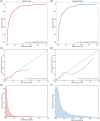Multisite development and validation of machine learning models to predict severe outcomes and guide decision-making for emergency department patients with influenza
- PMID: 38500599
- PMCID: PMC10945311
- DOI: 10.1002/emp2.13117
Multisite development and validation of machine learning models to predict severe outcomes and guide decision-making for emergency department patients with influenza
Abstract
Objective: Millions of Americans are infected by influenza annually. A minority seek care in the emergency department (ED) and, of those, only a limited number experience severe disease or death. ED clinicians must distinguish those at risk for deterioration from those who can be safely discharged.
Methods: We developed random forest machine learning (ML) models to estimate needs for critical care within 24 h and inpatient care within 72 h in ED patients with influenza. Predictor data were limited to those recorded prior to ED disposition decision: demographics, ED complaint, medical problems, vital signs, supplemental oxygen use, and laboratory results. Our study population was comprised of adults diagnosed with influenza at one of five EDs in our university health system between January 1, 2017 and May 18, 2022; visits were divided into two cohorts to facilitate model development and validation. Prediction performance was assessed by the area under the receiver operating characteristic curve (AUC) and the Brier score.
Results: Among 8032 patients with laboratory-confirmed influenza, incidence of critical care needs was 6.3% and incidence of inpatient care needs was 19.6%. The most common reasons for ED visit were symptoms of respiratory tract infection, fever, and shortness of breath. Model AUCs were 0.89 (95% CI 0.86-0.93) for prediction of critical care and 0.90 (95% CI 0.88-0.93) for inpatient care needs; Brier scores were 0.026 and 0.042, respectively. Importantpredictors included shortness of breath, increasing respiratory rate, and a high number of comorbid diseases.
Conclusions: ML methods can be used to accurately predict clinical deterioration in ED patients with influenza and have potential to support ED disposition decision-making.
© 2024 The Authors. Journal of the American College of Emergency Physicians Open published by Wiley Periodicals LLC on behalf of American College of Emergency Physicians.
Conflict of interest statement
A. S., M. T., and S. L. participated in this work while employed by Johns Hopkins University but subsequently became employees of Beckman Coulter Diagnostics, where they contribute to the development of CDS tools. J. H. is a paid scientific consultant for Beckman Coulter Diagnostics. Beckman Coulter played no role in this study and no technology owned or licensed by Beckman Coulter was used. The remaining authors declare no competing financial or non‐financial interests.
Figures



References
-
- CDC . Burden of Influenza. Disease Burden of Influenza. Published January 10, 2020. Accessed February 15, 2020. https://www.cdc.gov/flu/about/burden/index.html
-
- Ali ST, Lau YC, Shan S, et al. Prediction of upcoming global infection burden of influenza seasons after relaxation of public health and social measures during the COVID‐19 pandemic: a modelling study. Lancet Glob Health. 2022;10(11):e1612‐e1622. doi:10.1016/S2214-109X(22)00358-8 - DOI - PMC - PubMed
-
- Centers for Disease Control and Prevention . National Ambulatory Medical Care Survey: 2016 National Summary Tables. Published online January 25, 2020. Accessed January 25, 2020. Published 2016. https://www.cdc.gov/nchs/data/ahcd/namcs_summary/2016_namcs_web_tables.pdf
-
- Augustine J. Latest data reveal the ED's role as hospital admission gatekeeper. ACEP Now. 2019;38(12):26.
-
- Fingar KR, Liang L, Stocks C. Inpatient Hospital Stays and Emergency Department Visits Involving Influenza, 2006–2016. Agency for Health Research and Quality; 2019:1‐24. - PubMed
Grants and funding
LinkOut - more resources
Full Text Sources
